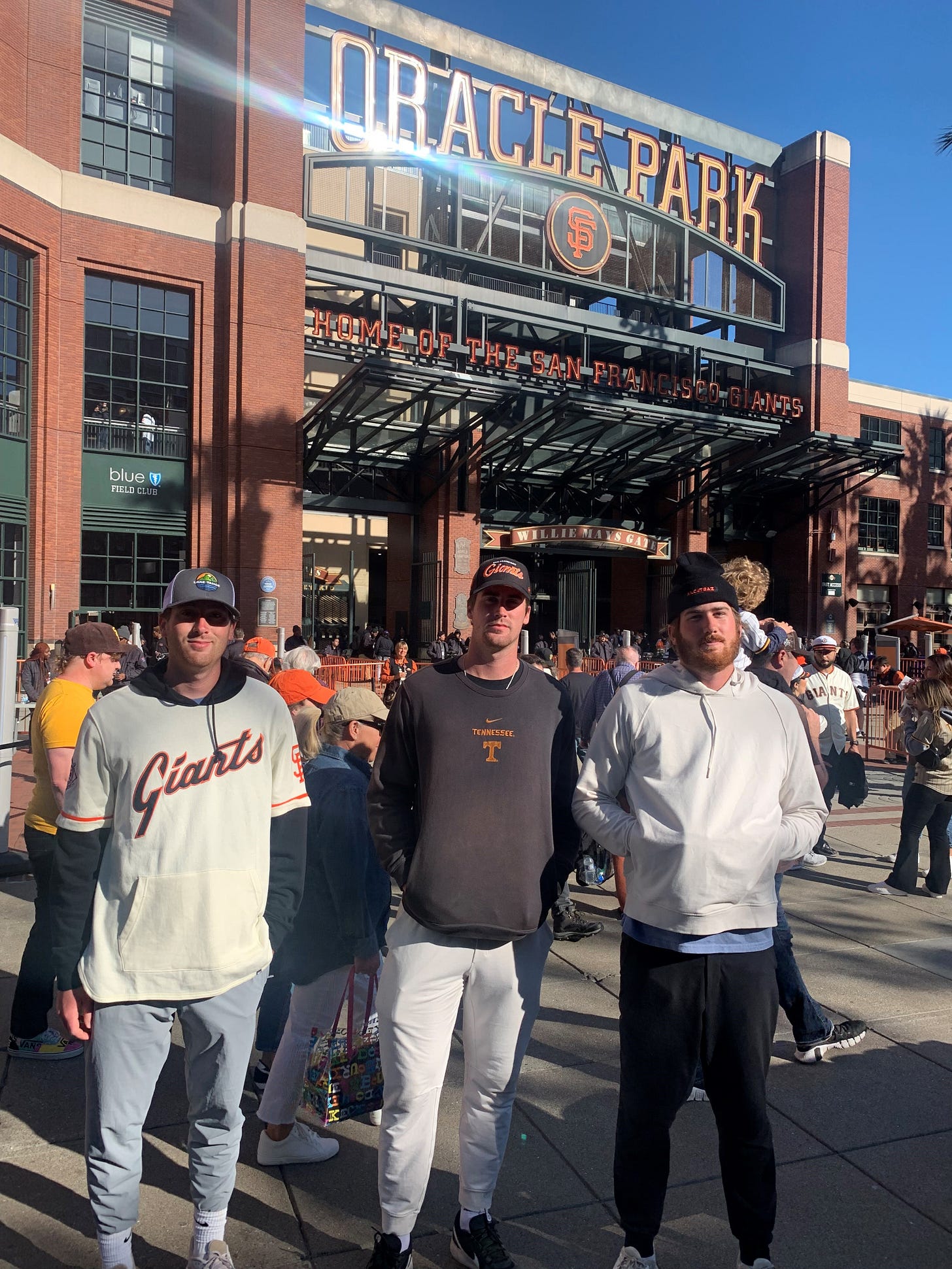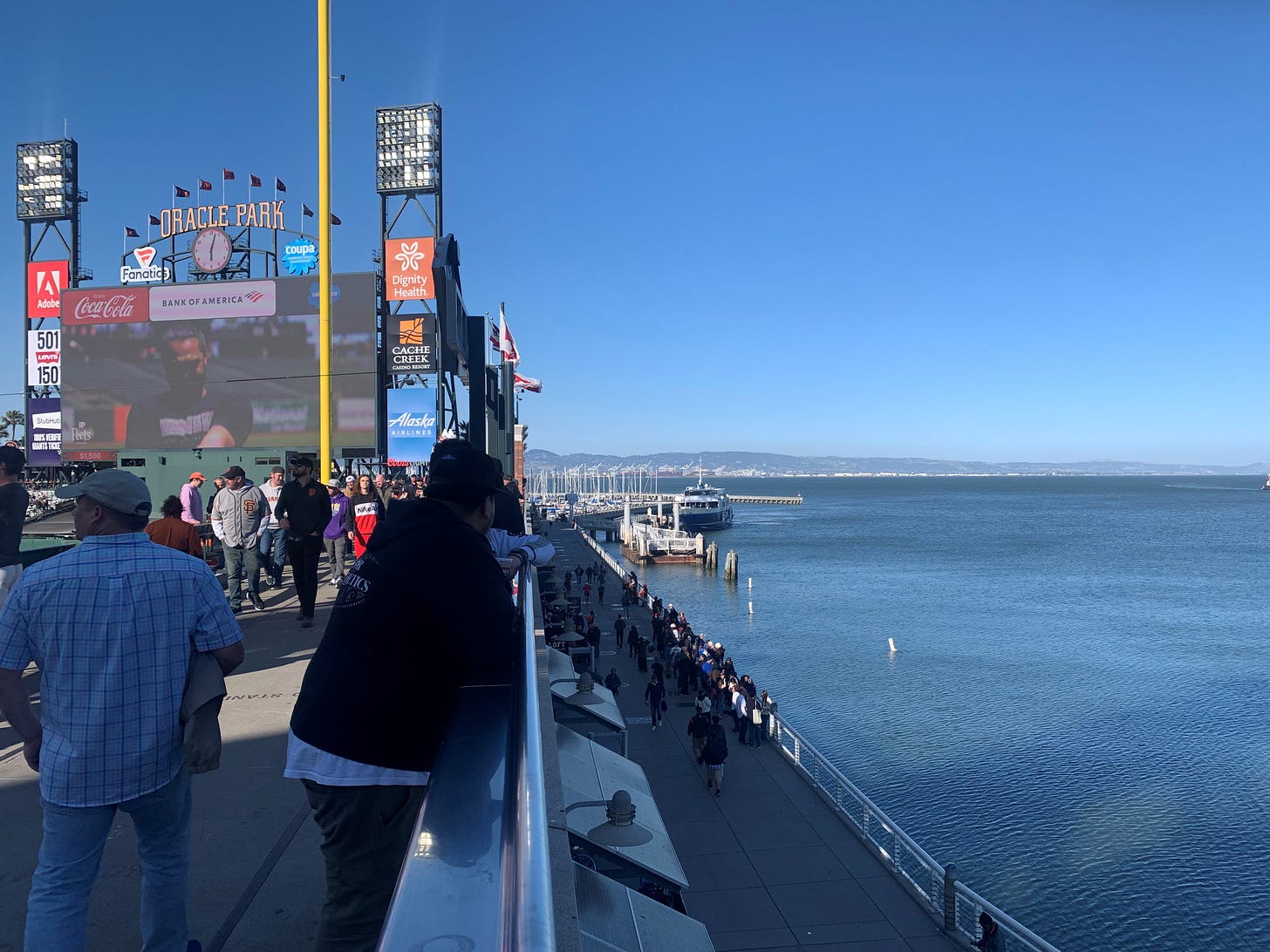We walked along the Embarcadero from Fisherman’s Wharf, heading south towards the Bay Bridge, feeling the warm late afternoon sun on our backs. As we approached the bridge, the financial district loomed on our right, with its bright, gleaming towers reflecting the light. To our left, out in the Bay, stood Yorba Buena Island, not as famous as Alcatraz, certainly, but much larger and greener. The sky was pale blue and cloudless, and the wind was picking up.
That’s the thing about San Francisco, even in late June. The wind is constantly there. It comes from off of the Pacific, having traveled thousands of miles, moving with an energy and a force that you simply can’t miss. It has a way of reminding you that you’re at the end of the continent, and there’s nothing beyond except the vast ocean.
After three miles or so, we came around a bend into the China Basin neighborhood, and there, jutting out onto a point of land beyond the city, we finally saw Oracle Park, the home of the San Francisco Giants since 2000. The Giants have won three World Series since moving in there, in 2010, 2012 and 2014. Our pace quickened a bit as we approached it.
We were outside the left field entrance when a friendly stranger noticed my Orioles hat and suggested we keep walking down the street to the home plate entrance and the plaza that had the Willie Mays statue. As we made our way down the sidewalk, I stopped to take pictures of the Gaylord Perry and Orlando Cepeda statues just outside the brick walls of the ballpark. That’s one of the many cool things about traveling to different baseball parks around the country; you see players who you had forgotten about, who are part of that team’s history, still remembered and revered all these years later.
Willie Mays Plaza was full of colorful banners and streamers and tall, slender palm trees. Fans milled about, taking pictures and greeting friends. The brick exterior and the exposed steel beams evoked the architecture of Oriole Park at Camden Yards. The atmosphere was warm and inviting. We strolled about and headed into the ballpark.
One of the first things you notice as you walk the lower concourse is the water of San Francisco Bay. It seems to shimmer out beyond right field, and no matter where you are in the park, it always catches your eye. I believe the best baseball parks all share that trait: A singular feature that is always associated with the place. In Baltimore, that’s the B&O Warehouse. In Boston, Fenway Park has the famed Big Green Monster, the 37-foot high leftfield wall that dominates the place. In San Francisco, it’s the water, and especially McCovey Cove, the inlet that’s situated just beyond the right field wall.
The water beckoned us, and so we went to the walkway that runs from the corner of the ballpark out beyond the bleachers in right field. As we followed the walkway, I couldn’t help noticing the actual cove sits about thirty feet below the wall of the stadium, and there’s a promenade below that wall. Any batted ball that clears the bleachers still has to travel another sixty feet or so to be considered a “splash hit” in McCovey Cove.
Turning towards the left field bleachers, the wind hit us with an impressive ferocity. There was a noticeable chill to it as well. I had told the boys before we left to pack a sweatshirt for San Francisco. Perhaps ski jackets would have been more appropriate. Whether he actually said it or not, Mark Twain’s famous quote has always stuck with me: The coldest winter I ever spent was a summer in San Francisco.
I made my way to a concession stand to order a coffee. I’ve been to hundreds of baseball games in the course of my lifetime, in approximately a dozen big league ballparks, and this was the first time I had ever ordered a coffee. Especially in June. As I waited, I looked to my right, and there beyond the stadium was a marina. Now I really had seen it all. The thing was, it felt as if it belonged. It wasn’t out of place in the least. It seemed like a perfectly San Francisco kind of scene.
We headed to the left field upper deck to find our seats and settle in. By now the wind was steady, and the occasional gusts went down the back of my sweatshirt and made it feel akin to being on a chairlift in the Sierra Nevadas. I wondered if there would be any vendors coming around selling coffee.
The views from our seats were spectacular. There was McCovey Cove across the field, and the San Francisco Bay, and across the water sat Oakland in the fading sunlight. It was as fine a view as anywhere in any ballpark in America. Oracle Park felt like it had always been there, like it never could have been built anyplace else.
In 1957, Major League Baseball went as far west as Milwaukee and St. Louis. As Walter O’Malley, then the owner of the Brooklyn Dodgers, was negotiating his move to Los Angeles with city officials there, he was told by MLB that the Dodgers couldn’t go to California without a second team moving there as well. So, O’Malley persuaded the owner of the New York Giants, Horace Stoneham, to initiate discussions with the city of San Francisco. This would insure the continuation of the Dodgers and Giants rivalry, albeit 3,000 miles west of New York.
So it came to pass that the San Francisco Giants began their history in 1958 in Seals Stadium, located in the Mission District. Seals Stadium had been the longtime home of the San Francisco Seals minor league baseball franchise that played in the old Pacific Coast League. The Giants played their first two seasons there before moving in to Candlestick Park, a little farther south of the present location of Oracle Park. They called “The Stick” home from 1960 to 1999. I couldn’t help but wonder if Horace Stoneham would believe his eyes if he saw Oracle Park.
One of my favorite pastimes when traveling is striking up random conversations with locals. As I waited for the boys to come back from a food run, I wandered over to a small kiosk on the upper deck concourse that was selling Giants merchandise. The gentleman working there noticed my orange Eddie Murray Orioles jersey and we began talking baseball.
He asked about our trip, and I told him we were heading down the coast to see Dodger Stadium and Petco Park. He told me about his ballpark trips to the East Coast, how he had seen Oriole Park at Camden Yards and loved it, his trip to Boston to see Fenway Park, and how, when he was a much younger man, he had gone to Shibe Park in Philadelphia. He had actually seen a game there in 1964 during the Phillies epic collapse at the end of the season, when they blew a five-game lead in the final two weeks of the season. He mentioned how he would take day trips to San Diego and Seattle with his wife, flying in to the city and taking the light rail to the ballparks.
We talked baseball for a few more minutes, reminiscing about the great players and teams we had seen, his of the Giants, and mine of the Orioles. I bought a San Francisco Giants baseball cap from him (the Classic all black one with the orange interlocking SF on the front) and thanked him for his kindness. Baseball always seems to bring out the best in people.
There were a lot of open seats along the front row in the upper deck in left field, so we moseyed over and took a row with an unobstructed view down the third base line. The game between the Giants and Padres was tight and tense; the Giants were on a seven-game winning streak, and their manager, Gabe Kapler, was making pitching change after pitching change, intent on continuing their run.
The sun was gone by now, and the temperature seemed to have dropped another ten degrees. I wondered what the wind chill index might show. A rowdy group of college students sitting below us didn’t seem to notice or care. They wore shorts and t-shirts and yelled at each other and some Padres fans sitting nearby. I guess the locals are used to June nights on the Bay.
The Giants won the game in the bottom of the ninth inning on a bases loaded walk to Joc Pederson with two outs. Everyone whooped and hollered, all the way down the ramps and out into the Embarcadero. I bought a grilled sausage with peppers and onions from a street vendor as we headed back towards Fisherman’s Wharf (those stands seem to be everywhere along the waterfront). The streets seemed energized and lively. Winning baseball games has that effect on a city.
We had spent two memorable days and nights in San Francisco. Everything about that city is unforgettable; nothing feels out of place or forced. Oracle Park belongs there, as much as Lombard Street and Ghirardelli Square and Chinatown and the Golden Gate Bridge. It’s a magical place, full of history and light and possibility.
I felt a slight twinge of melancholy as we got in the car to leave the next morning. We passed the ballpark as we made our way south out of the city, headed for the Monterey Peninsula. No matter how many times I’ve been there, I find it hard to say goodbye to San Francisco. There really aren’t many places in this world that evoke the same emotions.
Perhaps it’s best to leave it to the great American writer John Steinbeck to speak on my behalf:
San Francisco put on a show for me. I saw her across the bay, from the great road that bypasses Sausalito and enters the Golden Gate Bridge. The afternoon sun painted her white and gold---rising on her hills like a noble city in a happy dream. A city on hills has it over flat-land places. New York makes its own hills with craning buildings, but this gold and white acropolis rising wave on wave against the blue of the Pacific sky was a stunning thing, a painted thing like a picture of a medieval Italian city which can never have existed. I stopped in a parking place to look at her and the necklace bridge over the entrance from the sea that led to her. Over the green higher hills to the south, the evening fog rolled like herds of sheep coming to cote in the golden city. I’ve never seen her more lovely. When I was a child and we were going to the City, I couldn’t sleep for several nights before, out of busting excitement. She leaves a mark.”








